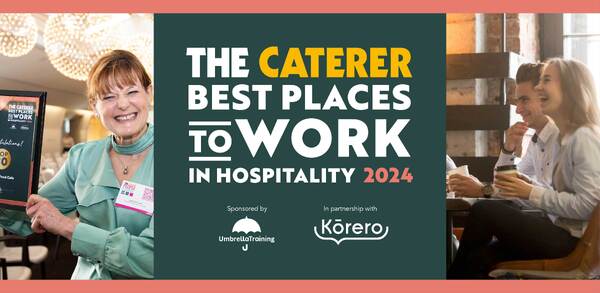Practical ways to prepare for Natasha’s Law and lessons learned from the Allergens Webinar
Last month The Caterer’s Allergens Webinar, sponsored by Nutritics, gathered food providers and allergen experts to look at how businesses will manage their compliance with the new legislation from October, from printing ingredients labels to communicating with chefs. Rosalind Mullen reports.


You can watch the full webinar here.
Is there already a good understanding about allergens in the industry?
Arvind Thandi (AT): The last key change on allergens was in 2014. Since then we have found that most businesses have a policy for managing allergens, but we can’t be complacent. We still get on average 10 deaths a year from hyper-allergic reactions and that is too many.
There has been a lot of regulatory change of late and there is also the small matter of the pandemic – are businesses ready for this legislation?
Rachel Ward (RW): The date of implementation is set for 1 October and it is highly unlikely that will change, but we recognise the challenges due to Covid. I recommend people look at the Food Standards Agency guidance (see Resources). The change to the ingredients list is the biggest technical effort – that is where people need to focus. And make sure you train the team and understand why you need to get it right.
Nutritics is an expert at food labelling processes – what do businesses need to consider?
Stephen Nolan (SN): It needs to be practically implemented. Consider what type of printer and labels you need. The labels will vary depending on what they are used for. For example, if packaged food is heated in the oven, standard labels will go black. Or if food is frozen, the adhesive may fail. Also, if an operative has a printer on-site that is fantastic, but once you print more than 75 labels a day over five days, you need to think about thermal printing, which is cheaper.
Are allergens higher on the agenda in schools now?
Amy Roberts (AR): Yes, we have seen an increase in allergies and intolerances that need to be managed at schools. Natasha’s Law will help, but it involves more processes for our teams to manage. We have a range of schools – some have small kitchens with two or three members of staff, and others have huge kitchens and feed thousands of children. It’s not just about understanding the legislation – it is about everything that goes around it.
Supplier engagement is important. Small suppliers are not familiar with the processes, so it is useful to set up forums for discussions. We need to all work together to help all parts of the chain implement the law.
We need to all work together to help all parts of the chain implement the law
Will it affect menu planning?
AR: Yes, we have always encouraged our chefs to develop their own menus and use their own suppliers, but now we have to educate them that when food is pre-packed they will have to write recipes and identify ingredients from set suppliers in advance. This will reduce flexibility in the kitchen on the day. We will be introducing more double-checking processes. We use Nutritics, which helps, but you still need endpoint checks to ensure the label matches what the chef has prepared. It is about getting the right processes in place and not rushing it.
We are about to start a trial on 19 April with a small group of schools. None of the information on labels will be shared with the other schools until we are 100% confident the data is correct – and we have 150 schools we need to have ready before 1 October. Then we will run trials with all to stress-test the labels.
SN: You can see the level of work there. You need to be ahead of the curve. You need to identify the pre-packed for direct sale [PPDS] items and then get a strategy on how to put processes in place.

So is there a typical amount of time that compliance will take, bearing in mind that Holroyd Howe is starting now?
SN: A couple of variables will determine the time it takes. In a significant majority of businesses, information will need to be gathered from suppliers, so the complexity of your supply chain is the big red flag. The second part is the creation of the recipes and products, which won’t take as long. Then there is the mobilisation and trialling. There is six months left – there is enough time.
So, what about good practice in working with suppliers?
RW: If you buy [premixed ingredients] from suppliers, you need to receive information in a sufficient level of detail to enable you to write the label. For instance, the description ‘spices’ doesn’t tell you if celery is included. If you have that information, it is a simple step-by-step process. You need to know what you buy and what you make and declare it on anything that you pre-pack.
It is complex for a business that has 3,000 suppliers and 25 sites and a menu that changes every day. Put all your effort at the front end. If a supplier makes a change to a dressing, it will have a knock-on effect, so make sure everything comes with a checklist. What happens if you change suppliers frequently? You need to apply a change management principle.
If a supplier makes a change to a dressing, it will have a knock-on effect, so make sure everything comes with a checklist
You need to get ahead. Start soon. You have already had to collect allergen information to give it verbally to customers, so you should have had it ages ago. But, you may not have had it in such a level of detail to write on an ingredients label.
AR: Get into the habit of using the same brand so you aren’t having to introduce checks each time. On our automated system if the supplier makes a change, there is a notification to our chefs.
Who should be responsible? Do you need an allergen champion?
RW: Everyone is responsible and you need to embed it with your staff – for instance, the reason why they are cleaning is that they don’t want to cross-contaminate because allergens can kill a customer.
Small operations that run out of ingredients may grab them from a shop. Learning how to read food labels is part of the training you need to integrate with your teams.
Work as a team and support each other with the knowledge you have. Allergies are so prevalent that some team members may have an intolerance – or a family member might – so get them to talk about it and make it real and personal, because it is personal.
AR: There is nothing more scary than a child having an allergic reaction. All members of the team need to have an awareness of their responsibility and understand allergens and how they can affect someone. But it might be wise to have a number of people who are more highly trained and empower the team be able to say: “I don’t have the answer but please let me get that for you.”
What are the penalties for getting it wrong?
RW: The sentencing guidelines are clear. If you place a product in the market with allergens that are not accurately declared, you could have created harm to someone with an allergy, so you will be sentenced accordingly with fines. If you are deemed to be deliberately negligent it will be dealt with as a criminal offence, so this is serious.

Will the legislation make people start to rationalise their offer?
SN: For some people, the solution is not to package anything, but if you put the work in, compliance is achievable. It’s a fear of the unknown, but once you get into it, it’s actually straightforward and there are various ways the process can be automated, from the way you get the information from suppliers or the way you print the label.
AR: We always have some mix of pre-packaged food and we won’t encourage chefs to stop providing these items because it helps with speed and choice. For us it is about being more prepared. So rather than printing a label that morning, chefs will have to know what the recipe is in advance to be prepared.
Using an automated system helps, especially around substitutions. It is scary if a supplier changes an ingredient.
Operators see this as fairly onerous – are there any reasons to be cheerful?
RW: You will get trust from the consumer and increase repeat footfall. One in five children has hypersensitivity, so that is two million families who are looking for somewhere to eat. It’s a good opportunity to show that you know what you are doing.
What is Natasha’s Law?
Natasha’s Law concerns the implementation of new ingredient labelling rules from 1 October. The law is in response to the tragic death of Natasha Ednan-Laperouse in 2016, who had an allergic reaction after unknowingly eating sesame in a baguette from Pret A Manger. This legislation aims to help people with allergies make safer food choices.
Natasha’s Law applies in England, Wales and Northern Ireland, with similar rules in Scotland. It applies to any premises where food is pre-packed for direct sale (PPDS) on the same premises before it is ordered by a customer.
Labelling rules
- PPDS items will have to clearly display a label headed ‘Ingredients’, where all ingredients must be listed in descending order of weight, with the 14 major allergens highlighted in bold, italics or capitals.
- The label must display a descriptive name of the food, for example, ‘cheese and pickle sandwich’, although customary names such as BLT are OK. Where names are prescribed in law they must be used.
- All label information should be clearly legible, using regulation font sizes.
What is PPDS?
Answer three questions: is the food presented to the customer in packaging? Is it packed before the customer orders it? Is it packaged at the same business where it is sold? If the answer to all three is ‘yes’, the food will require PPDS labelling.
PPDS foods also include food that is sold on temporary premises, such as marquees and market stalls, if it is offered by the same business that packed it.
Non-PPDS foods are: those that are not in packaging before the customer orders it; those pre-packed by a different business; food packaged at the customer’s request; and distance sales such as food ordered online. But you still need to make allergen information available as is already enshrined in law.
‘May contain’ labels
Arvind Thandi pointed out that unintentional cross-contamination information must be provided on labels, such as ‘may contain nuts’, but added this can be used “only if there is a real risk after a thorough check where risk can’t be removed”. She added: “Any cautions from a supplier must be passed on”.
This risk assessment is to deter operators trying to cover themselves by putting “may contain” on every label. All agreed that if this practice was widespread it would reduce the choice for consumers with allergies and become meaningless.
“The use of ‘may contain’ has increased; we will do some work on that this year, which may lead to change and guidance. Don’t use it as a ‘get out of jail free’ card,” said Thandi.
Rachel Ward argued that cross-contamination is eradicated by good hygiene practices. “Excellent hygiene will deliver cross-contamination control, so make sure that pan or wok is clean before you put your next product on it. That is good hygiene,” she said.
“Make sure there are no bags spilling out onto different shelves – that is bad hygiene from a pest-control practice anyway. You need to be clean and tidy and segregated in your storage, and you will manage cross-contamination and you won’t have to put ‘may contain’ on your labels.”
You can watch the full webinar here.
Resources
Allergy training updates, dedicated pre-packaged labelling pages and sector guides
Institute of Food Science & Technology
An independent membership body supporting food professionals through knowledge sharing and professional recognition
Best practice for pre-packed foods which include or exclude cereals containing gluten
A non-profit information group set up by Nutritics and experts in food, nutrition and allergen research and labelling from Manchester Metropolitan University, EuroFir and Quadram Institute
You can watch the full webinar here.

















